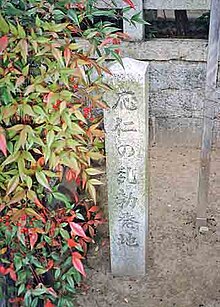Ōnin war
As Ōnin War ( jap. 応仁の乱 , Ōnin no Ran ) is a civil war in Japan called that during Ōnin - time of 1467 bis 1477 lasted. The conflict ended the rule of the Ashikaga - Shoguns and ushered in the Sengoku period , a more than 100-year period of continuous wars and unclear political conditions.
Triggers and Causes
The Ōnin War was triggered by a dispute over succession in the Ashikaga family. Ashikaga Yoshimasa , as he had no direct successor, appointed his brother Yoshimi as his successor. About a year later, Yoshimasa's son Yoshihisa was born. Yoshimasa now wanted his son to succeed him. Since the Ashikaga shogunate already lost a lot of its influence under Yoshimasa's rule, the powerful families in the country sensed their chance. They took position and each supported one of the two aspirants to the position of shogun.
The main adversaries to the conflict were the Yamana and Hosokawa clans . As the shoguns became increasingly weak, the families had already struggled for influence. Now the competition escalated in an open war. The Yamana stood behind Yoshihisa, the son of the Shogun, the Hosokawa behind his brother Yoshimi. The side of these large families also divided their vassals.
Course of war
In 1467 the Hosokawa had about 80,000 men and the Yamana about 85,000 men in Kyoto , the capital of the time. Neither of the two parties could and wanted to start the war, because this would have meant opposing Ashikaga Yoshimasa, the ruling Shogun. Up until the altennin War, the political ideas of ancient Japan were always based on an apparent legitimation, the old order was disempowered, but formally retained (cf. the overlapping of the imperial administration of the Heian period by the Kamakura shogunate ). The Yamana broke this stalemate by bringing in more troops and setting fire to the Hosokawa camp. By July 1467 the fighting had reached the proportions of a war. Unfortunately, this war raged in and around the capital, which led to the fact that Kyōto's north was completely destroyed; this resulted in an exodus of the urban population.
Although the commanders of both sides, Yamana Sōzen and Hosokawa Katsumoto died in 1473, the fighting continued. After 10 years the capital was a mountain of rubble and both clans had not achieved a victory. In addition, the feudal lords and their warriors were far from their territories, which no one cared about. In 1477 the situation had become intolerable and they withdrew. It is not entirely clear what ultimately ended the war, but Ōuchi Masahiro , a leader of the Yamana, is said to have decided to return with his army to his home country near Yamaguchi . After the troops withdrew, the capital remained completely devastated.
Political Consequences
The fact that a war raged in the capital for 10 years shows the powerlessness of the Ashikaga shogunate. Yoshimasa, whose succession rivalry made the Ōnin War possible, was the last Ashikaga to rule with a certain political autonomy. For a while, the Hosokawa ruled the remnants of the shogunate over puppet rulers from the Ashikaga line, but the central government structures had largely lost their importance. From then on, conflicts flared up all over the country and the old social order dissolved. In an effort to gain power, vassals turned against their daimyo , which had been an almost unimaginable event until then. Large family associations split up or were wiped out, and military power became the only legitimation for action. The Warring States Period ( Sengoku-jidai ) began.
literature
- H. Paul Varley: The Ōnin-War (Studies in Oriental Culture, No. 1), New York & London: Columbia University Press 1967. Reviews and Notices of Books ( Memento January 9, 2011 in the Internet Archive ) (PDF file ; 1016 kB)
- Joyce Ackroyd, Lessons from History: The Tokushi Yoron , Brisbane, University of Queensland Press, 1982, ISBN 978-0-702-21485-1
- Mark Ravina, "State Building and Political Economy in Early Modern Japan," Journal of Asian Studies, 1995
- George Sansom, A History of Japan, 1334-1615 , Stanford, Stanford University Press, 1961, ISBN 0-8047-0525-9
- Stephen R. Turnbull, The Samurai: A Military History , London: Routledge 1996, ISBN 1-8734-1038-7
- Varley, H. Paul, Japanese Culture: A Short History , London, Farber and Farber, 1973, ISBN 978-0-275-64370-6
